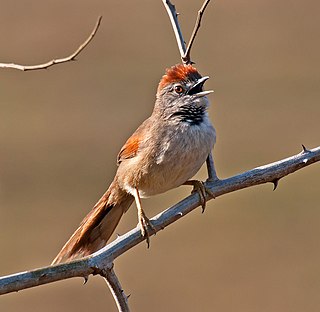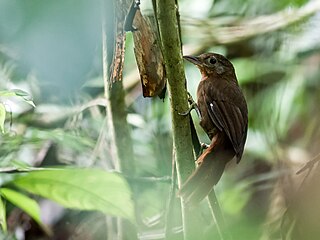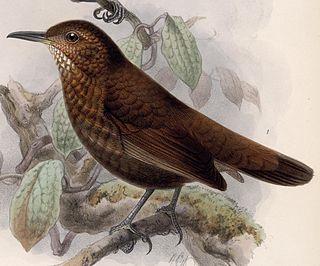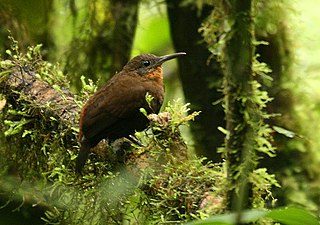
The pale-breasted spinetail is a passerine bird in the Furnariinae subfamily of the ovenbird family Furnariidae. It is found in Costa Rica, Panama, Trinidad, and in every mainland South American country except Chile and Ecuador.

The buff-throated woodcreeper is a species of bird in the subfamily Dendrocolaptinae of the ovenbird family Furnariidae. It is found in Bolivia, Brazil, Colombia, Ecuador, French Guiana, Guyana, Peru, Suriname, and Venezuela.

The wedge-billed woodcreeper is a sub-oscine passerine bird in subfamily Dendrocolaptinae of the ovenbird family Furnariidae. It is found in Mexico, Central America, Brazil, Bolivia, Ecuador, French Guiana, Guyana, Peru, Suriname, and Venezuela.

The chestnut-headed crake is a species of bird in subfamily Rallinae of family Rallidae, the rails, gallinules, and coots. It is found in Bolivia, Brazil, Colombia, Ecuador, and Peru.

The chestnut-winged hookbill is a species of bird in the Furnariinae subfamily of the ovenbird family Furnariidae. It is found in Bolivia, Brazil, Colombia, Ecuador, and Peru.

The streak-backed canastero is a species of bird in the Furnariinae subfamily of the ovenbird family Furnariidae. It is found in Argentina, Bolivia, Colombia, Ecuador, Peru, and Venezuela.

The ochre-throated foliage-gleaner is a species of bird in the Furnariinae subfamily of the ovenbird family Furnariidae. It is found in Panama and every mainland South American country except Argentina, Chile, Paraguay, and Uruguay.

The ruddy foliage-gleaner is a species of bird in the Furnariinae subfamily of the ovenbird family Furnariidae. Its range is highly disjunct, with populations in Mexico, several Central American countries, and in every mainland South American country except Argentina, Chile, Paraguay, and Uruguay.

The eastern woodhaunter, also known as the Amazonian woodhaunter, is a species of bird in the Furnariinae subfamily of the ovenbird family Furnariidae. It is found in Bolivia, Brazil, Colombia, Ecuador, Peru, and Venezuela.

The chestnut-winged foliage-gleaner is a species of bird in the Furnariinae subfamily of the ovenbird family Furnariidae. It is found in Bolivia, Brazil, Colombia, Ecuador, Peru, and Venezuela.

The grey-throated leaftosser is a Near Threatened species of bird in the subfamily Sclerurinae, the leaftossers and miners, of the ovenbird family Furnariidae. It is found in Bolivia, Brazil, Colombia, Costa Rica, Ecuador, Panama, Peru, Trinidad and Tobago, and Venezuela.

The black-tailed leaftosser is a species of bird in the subfamily Sclerurinae, the leaftossers and miners, of the ovenbird family Furnariidae. It is found in Bolivia, Brazil, Colombia, Ecuador, French Guiana, Guyana, Peru, Suriname, and Venezuela.

The scaly-throated leaftosser is a species of bird in subfamily Sclerurinae, the leaftossers and miners, of the ovenbird family Furnariidae. It is found in Mexico, every Central American country except El Salvador, and in Colombia and Ecuador.

The tawny-throated leaftosser is a tropical American bird species in subfamily Sclerurinae, the leaftossers and miners, of the ovenbird family Furnariidae. It is also known as the Middle American leaftosser and less frequently as tawny-throated leafscraper, Mexican leaftosser or Mexican leafscraper. It is found from Mexico to Panama.

The rufous-breasted leaftosser is a species of bird in the subfamily Sclerurinae, the leaftossers and miners, of the ovenbird family Furnariidae. It is found in Argentina, Brazil, and Paraguay.

The spectacled prickletail is a species of bird in the Furnariinae subfamily of the ovenbird family Furnariidae. It is found in Colombia, Ecuador, and Peru.

The chestnut-throated spinetail is a species of bird in the Furnariinae subfamily of the ovenbird family Furnariidae. It is mainly found in Bolivia, Brazil, Colombia, Ecuador, and Peru.

The ruddy spinetail is a species of bird in the Furnariinae subfamily of the ovenbird family Furnariidae. It is found in Bolivia, Brazil, Colombia, Ecuador, Guyana, Peru, Suriname, Venezuela, and possibly Guyana.

The ocellated woodcreeper is a species of bird in the subfamily Dendrocolaptinae of the ovenbird family Furnariidae. It is found in Bolivia, Brazil, Colombia, Ecuador, Peru, and Venezuela.

The dusky leaftosser or South American leaftosser is a bird in subfamily Sclerurinae, the leaftossers and miners, of the ovenbird family Furnariidae. It is found in Bolivia, Brazil, Colombia, Ecuador, French Giana, Guyana, Panama, Peru, Suriname, and Venezuela.























